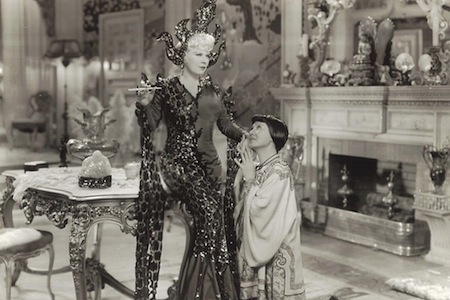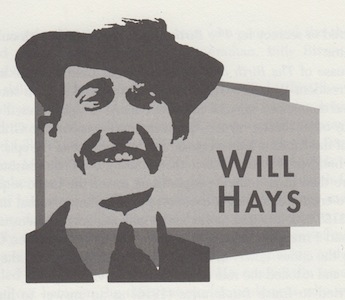Born: November 5, 1879, Sullivan, IN
Died: March 7, 1954, Sullivan, IN
It wasn’t a job that had been offered to him. It was a challenge, a duty.
—Raymond Moley
At the height of the Jazz Age, the film industry faced its first major offensive from moral arbiters. By the early 1920s, forty million Americans were making weekly trips to the movies, and half were minors. Films with racy plots, dark themes and cynical endings became an increasing concern. Making matters worse was the involvement of major Hollywood names in a wave of off-screen scandals: Fatty Arbuckle was acquitted in the rape and murder of a Hollywood starlet; William Desmond Taylor was found shot to death; popular comedian Wallace Reid died of a drug overdose and swashbuckling idol John Gilbert had turned to alcohol and drank himself to a premature death.
Community leaders across the country responded by organizing local censorship boards. Frightened by the prospect of making movies that would have to meet standards in states as vastly different as Iowa and New York, Hollywood put out the word that it would police itself. Leaders of the studios, headed by Louis B. Mayer, successfully thwarted the possibility of government regulation by banding together in 1921 to form an organization to curb questionable content in films, the Motion Picture Producers and Distributors of America, Inc. (MPPDA), but to quell the increasing pressure from the media, they needed a president who would appear fair and objective. The job was offered to Will Hays.
Hays, a politically active lawyer from Indiana who had headed the Republican National Committee in 1918, was rewarded the position of U.S. Postmaster General in Warren Harding’s administration in 1921. A respected and dignified elder in the Presbyterian Church, Hays readily accepted the position as the new head of the MPPDA a year later. He was immediately embraced by studio bosses eager to show their compliance with the public’s demands and desperate to improve the image of their troubled industry. Hays went to work immediately, blacklisting Hollywood regulars, writing moral clauses into studio contracts and campaigning in highly visible forums about the changes he was instituting.
Certain celebrities, however, were too powerful or too clever to be scared by Hays. Cecil B. DeMille found the whole business offensive and turned out such flesh-and-blood spectacles as The Ten Commandments (1923) simply to prove the ineffectiveness of Hays. Ernst Lubitsch used slyer means, littering his comedies with double entendres and sexual innuendo so skillfully that Hays and his staff of censors seldom caught the references.
In 1930, after it became obvious that a public relations campaign was not enough, Hays outlined a set of strict guidelines for moviemaking: the Production Code, commonly called the Hays Code. Through it, Hays wielded his power until he had single-handedly reshaped the image of Hollywood. The Code, revised to an even greater scope in 1934, detailed unacceptable screen portrayals and required all scripts to pass through censors. No films made from 1930 to 1966 could show the inside of a woman’s thigh under any circumstances, nor could a dead body appear on the screen. Drinking, gambling and narcotics use were banned. The gangster’s tommy gun was out, as was lace lingerie. Because the Code was extremely specific, censors were able to follow it to the letter. With little room for interpretation, Hollywood screenwriters were forced to avoid its no-nos, and costume designers, cameramen and directors learned it inside out. Some attempts bordered on the ludicrous: when censors suggested that Clark Gable’s famous line in Gone with the Wind be altered to “Frankly, my dear, I don’t care,” producer David O. Selznick became livid and stonewalled the production until Mayer spoke to Hays.
Although the Hays Code was officially in place until 1966, several landmark films tested its rigidity over the years. Sex goddess Mae West used her voluptuous lips to utter risqué innuendos in films like the notorious Klondike Annie (1936) and became quite skillful at passing scripts through censors, then applying sexual meanings through clever delivery of her lines while filming. Many of these lines found their way into the vernacular, sparking the Hays Office to battle her over virtually every other word of dialogue. At the peak of the actress’s popularity, the Production Code was nicknamed “the Code of the West.” Ultimately, censorship damaged West’s career, but the controversy inspired others to join the battle.
Two landmark challenges were made by director Billy Wilder, first in Double Indemnity (1944), which featured a steamy plot to bump off a husband for insurance money. The femme fatale gets away with murder, a strict violation of the Code, but after much wrangling Wilder was allowed to keep the ending. Such small acts of leniency encouraged other filmmakers to push the limits of the censors. A principal character in another Wilder picture, The Lost Weekend (1945), was an unabashed drunk, a portrayal routinely tolerated by the Hays Office. Lost Weekend, however, exposed a double standard; by detailing the devastating effects of alcohol abuse, the powerful film was instrumental in exposing the hypocrisy of the Code.
Nevertheless, the influence of the Hays Code was significant—it altered the creative product of Hollywood for more than thirty-five years. Hays maintained his advisory role with the MPPDA as president until 1945. By then, the self-regulatory rules were firmly in the hands of studio executives, and Hays returned to his native state. In 1966, the Code had become outdated and was feared to be ineffective against the changing social mores of the liberal 1960s. It was altered to curb sexual content in broader terms, and definitive language requirements were made. In 1968, an adjusted system was developed by the Motion Picture Association of America (MPAA, the MPPDA’s successor) rating films according to their suitable audience: it set up G (general, for all audiences), M (mature), R (restricted; children under eighteen must be accompanied by an adult) and X (over eighteen only). Soon PG (briefly GP) was added as a parental guidance signal, replacing M, and since 1984 PG-13 has cautioned parents of stronger content. After much debate, NC-17 replaced X in 1990 to ensure that no children under seventeen are admitted to films of an adult nature. Besides the rating system, the MPAA works to develop international distribution of films, advises studios on special tax issues and continues public relations efforts for the entire industry. But the Hollywood blacklists of the 1950s and the recent attacks by politicians on the values of Hollywood filmmakers echo the beliefs of the original MPPDA founder. The Hays legacy lives on.
To read all the republished articles from ‘The Film 100,’ go to Reintroducing the Film 100 here on Keyframe.





